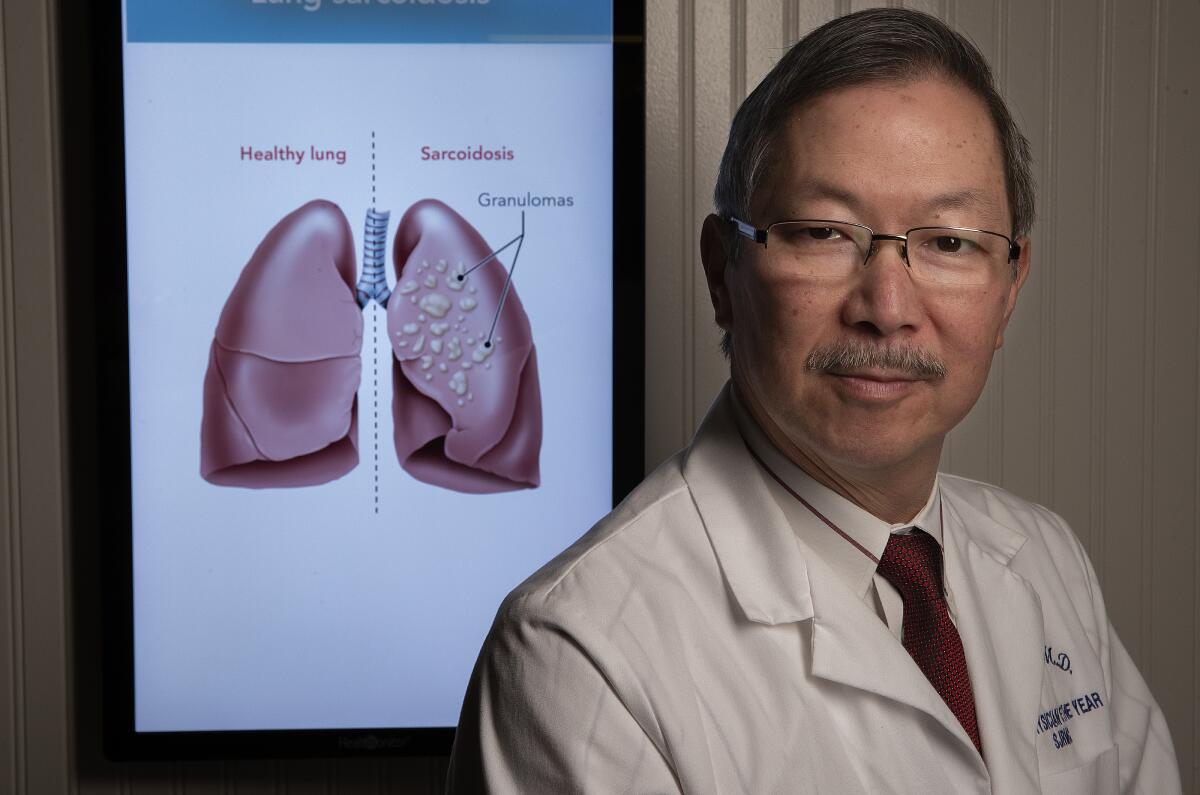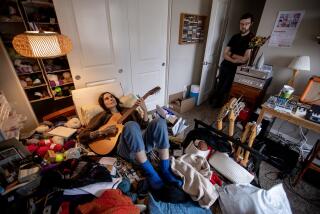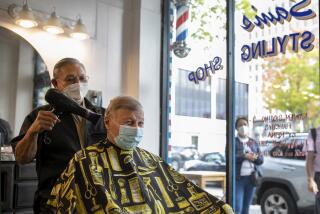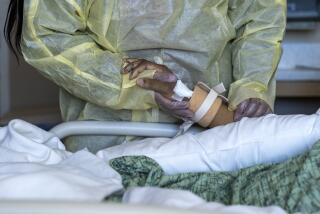Column: His patient near death, this determined doctor recruited a COVID-19 survivor to donate plasma
- Share via
Dwight Everett, a 65-year-old retired electrician, had just recovered from COVID-19.
Ron Shirley, an 80-year-old retired gas company planner, was being ravaged by the same disease.
Both Camarillo residents were patients of Dr. George Yu, a pulmonary specialist who in late March had just read about the promising results of a study in China, where sick patients improved after infusions of plasma from those who had recovered from COVID-19.
“When I saw Ron on a ventilator, the thought that came to me was that I have Dwight, and wouldn’t it be nice if I could link the two together,” said Yu. The experimental treatment was being tried in a few locations in the United States, Yu said, but this would be the first time in Ventura County.
First they needed to check blood types, but that hurdle was cleared when they discovered Everett and Shirley were a match.
Then Everett had to test negative for at least 14 days.
At last he did, and he was eager to help.
“I had no reservations whatsoever,” said Everett.
Shirley was at St. John’s Pleasant Valley Hospital in Camarillo, and Yu knew there’d be legal, ethical and regulatory challenges to work through. But Shirley’s condition was critical and he didn’t have much time.
Dr. Lynn Jeffers, the hospital’s chief medical officer, was tentatively on board. She thought the use of plasma from convalescent COVID-19 patients made sense in theory, and recalled that the same antibody treatment had been used with some success during previous virus epidemics. She talked to the hospital’s lawyers and the Food and Drug Administration about how to proceed, then convened a two-hour conference call April 3.
“We wanted to be sure we were doing it right,” said Jeffers.
“Anyone could have said no, we don’t want to do it,” said Yu, who was on the conference call. “But everyone came forward and said we’re trying to save a life. It was the most collaborative and compassionate coming together of a group of medical professionals and administrators I’ve ever witnessed.”

Yu and the rest of the staff knew that the treatments, even if successful for some patients, wouldn’t be a miracle cure. And even if critically sick patients recovered, the medical team might never know whether it was the plasma or something else that made the difference. But we are in uncharted waters with this virus, and at hospitals across America, healthcare workers are taking unprecedented steps to try to save their patients from its ravages. Yu was determined to use every potential tool in his arsenal.
Everett’s plasma was pushed into Shirley’s body. But there was little improvement.
“That night I thought we were losing him and I sent a text to everyone saying it didn’t look like Ron would make it through the night, but I was so proud of them for signing off on this,” Yu said. “And then I started crying.”
The next morning, Yu got word that Shirley was still alive and slightly improved.
“I was flabbergasted,” said Yu.
But the improvement was fleeting, and Shirley died April 9, his organs under attack from a viral storm.
Shirley’s wife, Zoe, a cancer survivor who is also recovering from COVID-19, was nevertheless grateful. “Dr. Yu moved mountains and broke protocol,” she said, “and I will forever be in his debt.”
Zoe Shirley described her husband as a soft-spoken, giving man who with his wife fostered 13 children and adopted four of them. She said she believes part of his legacy is to have been a local pioneer, along with Dwight Everett, in the use of plasma as a potential treatment.
Since Shirley’s death, plasma from Everett has been used to treat at least two other patients, and more plasma donors have now stepped forward.
“We are seeing some promising signs from the infusions we’ve done,” said Jeffers. It’s still too early to establish strong evidence that the plasma is what’s making the difference, but Jeffers said the results have nevertheless been encouraging.
Everett said he learned from doctors that some of his plasma was taken to Marian Regional Medical Center in Santa Maria and used to treat a critically ill female COVID-19 patient who, like Shirley, was on a ventilator. That woman’s husband, Louis Meza, a chef who also has a landscaping business, said he was told by one of his wife’s doctors that Everett was the donor, and the two men talked by phone.
“He just wanted to thank me so much for donating and he wanted to let me know that he was also recovering from COVID-19,” said Everett.
In fact, Louis Meza was hospitalized for six days. On the day he left the hospital to quarantine at home, where he is still recovering, his wife, Melissa, who works in the operations division of a Santa Maria bank, went into the hospital with a severe case of the virus and was intubated and placed on a ventilator.
Meza said his wife was so sick, even after the plasma infusion, that her doctors wanted to transport her to Providence St. John’s Health Center in Santa Monica to put her on a lung bypass machine called an ECMO. But they weren’t sure she could survive the nearly three-hour ambulance ride.
One of Melissa Meza’s doctors, pulmonary and critical care specialist Baljinder Sidhu, spoke to Louis Meza about the risks and possible benefits of moving his wife to Santa Monica.
Sidhu said that while he thought it was Melissa’s best hope, he couldn’t guarantee Louis that a three-hour trip would have no adverse consequences for his wife.
They looped in a physician who is a Meza family friend, and after talking it over, Louis decided to green-light the trip.
“She had not been improving,” he told me. “For three days prior, she was 100% on the ventilator, couldn’t breathe, with a fever of 103 and 104, and her white cell blood count was high.”
Meza believed it might be his wife’s only hope.
“They transferred her on Easter day, at 6:30 in the evening,” Louis Meza said.
Dr. Sidhu decided to travel with Mrs. Meza in the ambulance, and he was in contact with Meza along the way to let him know how it was going.
“He called and said, ‘We just hit Santa Barbara,’” Meza said. “I owe this doctor everything. I’m not kidding you, this guy went above and beyond, riding in the ambulance all the way to make sure she got there safely.”
Sidhu told me Melissa Meza’s blood pressure fell on the trip. He texted surgeons and other staff at St. John’s along the way, letting them know when the ambulance was approaching. Sidhu’s voice broke when he described arriving at the hospital in Santa Monica and being met by a medical team of 20 or so.
“They turned an ICU unit into an operating theater,” Sidhu said.
A breathing tube was inserted into Mrs. Meza’s neck, Sidhu said. With another surgical procedure, blood was siphoned from her body, drawn into a machine and pumped back into her body to stabilize oxygen levels.
When I spoke to Louis Meza on Thursday, he was feeling cautiously upbeat for the first time in weeks. He said Melissa had finally shown some improvement that morning. On Friday, she was even more alert during a video call. Meza said he knows his wife is still extremely ill, with a long recovery ahead, but he was encouraged by what he saw. He told her she had missed Easter, their anniversary, and her 43rd birthday.
“She was opening her eyes,” Louis said. “I told her, ‘I love you,’ and she mouthed back, ‘I love you.’ I blew her a kiss and she blew me one back. She was smiling. It’s incredible. I’ve been on Cloud 9.”
Sidhu told me Mrs. Meza remains quite ill, and said it’s hard to know whether the ECMO, steroids, plasma infusion or other therapies led to her improvement. It might have been a combination of those things, he said, adding that he thinks plasma infusions might be helpful for some patients going forward, but the science of how to treat the coronavirus is young and still evolving, with many lessons still to be learned.
You have to be inspired, though, and take a measure of hope, in the human spirit of survival, and in all the courageous efforts of so many medical professionals who are themselves at great risk.
Until there’s a vaccine and proven remedies, Yu said, antibody-rich plasma is one tool to lean on, and a single donation can be used on several patients.
“We can reach out and touch someone in the most intimate way, and there are thousands of recovered individuals who could potentially be donors,” said Yu.
In Camarillo, Jeffers said the website conquercovidtogether.com has been set up to accept plasma donations. Donors can give as often as once a week. The Red Cross also has a donation website for COVID-19 survivors.
In Santa Maria, Louis Meza, still praying his wife gets through this ordeal, told me he is hoping to test negative soon so that he can donate plasma. With both him and his wife out of work, and bills piling up, he said he’s been humbled by the response to a Gofundme page set up for the family.
In Camarillo, Dwight Everett — who got sick after a cruise ship vacation, and became worried after learning another passenger had died — said he plans to donate more plasma soon.
And Zoe Shirley said she plans to donate, too, in the name of her husband of 30 years.
“I think God is pulling us all together,” she said, “to give what we can, unselfishly, one people.”
More to Read
Sign up for Essential California
The most important California stories and recommendations in your inbox every morning.
You may occasionally receive promotional content from the Los Angeles Times.











